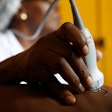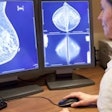As breast imaging facilities consider new technologies as possible adjuncts to mammography, the weak economy is becoming a factor in their decision-making process. In the face of falling patient volumes and squeezed capital equipment budgets, could molecular breast imaging (MBI) offer an alternative that enables breast centers to do more with less?

But MBI's arrival in the market -- with the new generation of solid-state digital dual-detector MBI systems just starting to ship this year -- comes at a difficult time for breast imaging. Many states have cut funding for breast screening programs due to the economic crisis, while women who have private coverage are confused over the recent controversy regarding mammography screening guidelines.
On top of that, the current reimbursement environment is hardly welcoming, with both third-party payors and Medicare casting a skeptical eye toward new technologies.
But with additional clinical validation, MBI's cost advantage over other adjunctive breast imaging technologies could enable it to carve out a niche as a complementary tool in the diagnostic workup of women with suspicious breast lesions.
How badly has the Great Recession affected mammography screening rates in the U.S.? Exact numbers are hard to come by, but anecdotal evidence indicates that it could be as much as a double-digit percentage decline in screening rates -- and that's on top of a 2% annual decline in screening mammography volume between 2000 and 2008 that's been documented by market research firm IMV Medical Information Division of Des Plaines, IL.
A typical scenario occurs when a woman finds herself out of work and losing her health insurance -- and, thus, access to subsidized or free mammography screening -- according to Bonnie Rush, president of Breast Imaging Specialists in San Diego.
"The loss of insurance has had a big impact as women [are putting] their own needs behind those of their families," Rush said.
Kathy Schilling, MD, medical director of imaging and intervention at the Women's Center - Center for Breast Care at Boca Raton Community Hospital in Boca Raton, FL, has seen a 13% drop in volume.
Concern regarding the effects of healthcare reform only adds to the uncertain environment. Shrinking resources make efficiency and appropriate technology decisions critical.
Given the economic situation, does it make any sense for breast imaging practices to look at acquiring new technology, especially something as novel as MBI? Ironically, yes, according to some breast imaging experts.

"Physicians and patients want a more expedient and specific exam, and nuclear medicine finds changes on a molecular level even before the angiogenesis that can be seen on an MRI," Rush said. "[It is] easy to interpret and the purchase price versus the reimbursement makes it doable."
How does the purchase price of an MBI system compare to that of other complementary breast imaging modalities? MBI developer Gamma Medica of Northridge, CA, sells a single-detector version of its LumaGem scanner for $295,000 to $349,000 and a dual-detector version for about $549,000. This compares to a list price of $900,000 to $1.3 million for a dedicated breast MRI system. MBI also has less onerous siting requirements than breast MRI, which can add as much as $300,000 for installation costs to the final price tag.
Rush cautions, however, that incorporating MBI technology into a breast care practice means "bridging the gap between anatomic and molecular imaging, [requiring] coordination and training for the nuclear medicine technologists and the breast imagers if they take over the interpretations."
Education and physician buy-in remain paramount. Investments in these areas can pay off with the development of a solid referral base and the dissemination of MBI information to patients as an option for equivocal screening studies. And MBI's novelty can be viewed as an advantage for breast centers looking to stand apart from the crowd.
"It is a great time to begin marketing the technology to set the facility apart from the competition and, thus, gain market share," Rush said.
So let's assume you've decided to take the plunge into MBI. Obtaining the technology and getting reimbursement require savvy. Key tasks for any center that's purchasing an MBI system include the following:
- Choosing the technology that offers additional benefits relative to mammography
- Finding innovative ways to raise capital equipment purchasing funds
- Educating third-party payors and radiology management companies about the advantages of molecular imaging
"[Providers] need to be aware of what reimbursement is [with significant payors in their areas]; how are things paid," said Barbara Ossias, principal of Reimbursement Revenue Solutions of Middletown, MD.
From providers to manufacturers, determining if a modality is covered before investing in the technology is a huge but often overlooked factor, according to Ossias. Expect to see more and more scrutiny going forward as MBI comes of age.
"When you come out with something new, it may not be that you're necessarily having trouble getting reimbursed; it is a situation where no one has ever been asked the question of covering you," Ossias said.
Fortunately, Medicare already reimburses for MBI, using CPT codes 78800 or 78801 for imaging and A9500 for the technetium-99m sestamibi radiopharmaceutical used in the procedure. The average reimbursement amounts (per scan) for MBI and other complementary breast imaging modalities are as follows:
- MBI -- $450
- Breast MRI -- $1,100
- Breast-specific gamma imaging (BSGI) -- $450
- Positron emission mammography (PEM) -- $1,100
But before you can get paid, you need to educate. Ensuring that all the players understand what a breast center wants to do is critical to reimbursement. The current approach, Ossias explained, involves not just working with each payor to establish a positive medical coverage policy, but also working with your radiology benefits management (RBM) company to make sure it understands what you want to do.
"We go to the radiology benefits firm [with] a luminary, a physician who believes in the service, and we start the education process," Ossias said. "They're not going to precertify something if they don't know what it is, what the cost is, and why it's something that has a beneficial outcome for the patient."
The good news, according to Ossias, is if a new technology's images are equivalent or better than those from the currently used modality, and if it's a much less expensive procedure to perform, payors will factor that into the equation.
Ironically, a breast center that adds more advanced procedures -- and, thus, more expensive equipment -- to its practice may actually have a better chance of escaping economic stagnation as it can offer a wider range of services and avoid referring patients out for more advanced procedures.

"You have to improve your efficiencies, and it becomes a lot easier for breast centers if they have some of the higher-end procedures, such as MRI, biopsy, or PET imaging," Schilling said. "It's difficult to have a mammo center where you just do mammography."
Schilling's center has improved its efficiency by doing same-day reads, in which patients' exams are interpreted at the same time they're being imaged. If patients need additional biopsies or imaging, they are scheduled internally to avoid losing them to another facility.
Treating patients more as individuals; learning biopsy histories, familial risk, and breast density; and offering additional screening tools make for more comprehensive care.
Centers that have already adopted digital mammography are probably better candidates for an MBI system compared to facilities that are still performing analog imaging. Digital imaging increases throughput, which, in turn, feeds more patients into adjunctive diagnostic modalities such as MBI.
"If [you] do additional mammos, it increases the number of breast MR studies that you do down the road," Ossias said. "As molecular breast imaging becomes more [commonplace], it will increase use of more of those [procedures], even more than basic ultrasound."
The arrival of new technologies can mean difficult choices. That's particularly true as MBI joins two other functional breast imaging modalities, BSGI and PEM, on the market, while other non-nuclear modalities, such as automated whole-breast ultrasound and conebeam breast CT, loom on the horizon.
The key is to seek out technologies that compensate for the well-known limitations of the current gold standard for screening: mammography. Breast centers need to look for technologies that fill in the gaps and help improve performance.
"You don't want to pick a tool that's going to give you nothing that's incremental," Schilling said. "You don't want a tool that is finding those same cancers [as mammography] because you're not gaining anything."
A breast center's existing technology and expertise can also factor heavily into its choice of new technology. Without MRI expertise, a center could prefer molecular imaging. Or if a center has an MRI scanner but can't afford the time on it, molecular imaging may be preferable.
Breast centers should examine their procedure volumes and the extent to which they're using existing equipment, Schilling explained. Physician preferences can also play a role. Some clinicians would rather do a nuclear study than an MRI study, and that weighs into the decision more than some of the other issues, according to Schilling.
Whatever the technology, reimbursement remains a critical component.
"Most centers are not going to be adopting things that aren't being reimbursed," Schilling said. "When most centers have no capital, I don't see why you would pick anything that is not going to add to your bottom line."
As payors continue to view imaging technologies as overly utilized, the reimbursement problem will be ongoing. All the new technologies face the same scrutiny.
"Until we can prove that it's an added benefit, they're not going to be that thrilled to introduce new codes," Schilling said.
Despite economic pressures, the practice of breast imaging is changing. Although x-ray-based mammography has been the gold standard for screening for decades, that doesn't necessarily mean it will still be the gold standard decades from now.
In fact, some MBI proponents believe the technology could develop into a screening modality for a larger population of women, such as replacing breast MRI, which is far more costly.
"As the technology is better understood, [I see it] becoming more of a screening tool because it's not so costly," Ossias said. "I think we're going to be screening more for the general population as opposed to just [women at] high risk."
Much of the recent controversy over mammography screening guidelines comes from an attempt to apply a one-size-fits-all approach based on age to determining when women should be screened. A better approach would be based on finding women at the highest risk of disease and having them undergo more frequent screening compared to women at lower risk.

"[For] high-risk women, MRI works well," according to Jennifer Harvey, MD, head of the breast imaging division at the University of Virginia Health System in Charlottesville. "I think another step we're going to be making over the next five to 10 years is figuring out that next rung of the ladder -- the women who are higher risk than average but not those ultrahigh-risk women."
MBI and other functional breast imaging technologies such as BSGI and PEM could play an increasing role in detecting cancers as early as possible in these women, especially those with dense breast tissue. However, the radiation dose involved in functional breast imaging remains a concern for screening. To that end, researchers at the Mayo Clinic in Rochester, MN, are developing technologies that could reduce MBI's radiation dose dramatically (see "Radiation dose in women's imaging: Are we scared yet?").
Another wild card is healthcare reform and the role it will play in women's imaging. On the positive side, reform could bring millions of uninsured women into the healthcare system, where they could receive relatively low-cost preventive care such as mammography screening that leads, in turn, to increased use of complementary modalities such as breast MRI, ultrasound, MBI, BSGI, and PEM.
On the negative side, the amount that the U.S. currently spends on healthcare is widely acknowledged to be unsustainable, especially given an aging population. Efforts to rein in spending could affect the dissemination and use of new technologies.
While some worry about what reform will bring, others see it as positive for women.
"I am concerned about being forced to ration [healthcare], including breast screening," Harvey said. "But ... if we invest our time and energy now into figuring out who can benefit the most from the resources we have, we may come out ahead of this [and] stop doing tests that are not getting much bang for the buck."
By Lin Muschlitz
AuntMinnie.com contributing writer
September 14, 2010
Disclosure notice: AuntMinnie.com is owned by IMV, Ltd.
Copyright © 2010 AuntMinnie.com

















